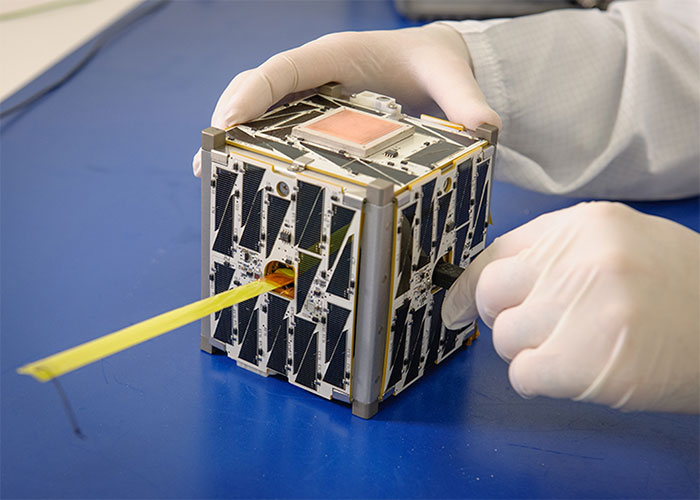Over the past two decades since their inception, the small satellites known as CubeSats, which are roughly the size of a shoebox, have significantly contributed to changing the world.
Uses of CubeSat Satellites
CubeSat was invented by Professor Bob Twiggs in 1999 as an educational tool for students at Stanford University (USA). Professor Bob Twiggs shared with the BBC (UK): “They can’t fit much into it, which is really a challenge. This forces them to abandon adding too many things to the design.”

A CubeSat satellite in NASA’s laboratory. (Photo: nasa.gov)
Typically, launching a satellite costs around $500 million; however, for a CubeSat, the price is only about $100,000. The faster and cheaper assembly of these satellites has led to hundreds of CubeSats currently in orbit around Earth. These satellites are created by universities, startups, and governments.
CubeSats typically operate for 2-5 years before burning up in the atmosphere, with their lifespan depending on the altitude at which they are launched into orbit. The first six CubeSats were launched into orbit in June 2003 from a launch site in Russia.
Reducing Deforestation
The Norwegian government has collaborated with the satellite company Planet to address global deforestation. Planet operates 180 CubeSat satellites that continuously capture images of Earth. The cameras on these CubeSats can document evidence of deforestation.
Planet’s CEO, Will Marshall, stated: “The Norwegian government has paid for data to trace deforestation in 64 countries. We provide information to the forestry departments in those countries about where deforestation is occurring, and Norway will fund them through an agreement to help prevent this.”
Detecting Modern Slavery
The unit “The Right Lab” at the University of Nottingham (UK) has utilized satellite imagery to infiltrate the underground world of forced labor. Recently, “The Right Lab” used images captured from CubeSat to locate temporary camps of Bangladeshi fruit pickers in Greece. The team then collaborated with a local NGO to visit the camps they identified.
Professor Doreen Boyd, who leads this project, remarked: “They can talk to the immigrants to gather more information about their living conditions.”
Monitoring Endangered Species

CubeSat satellites have contributed to changing the world. (Photo: Getty Images).
Earlier this year, a team of students from Italy and Kenya used CubeSat to monitor birds and various mammals in Kenya’s National Parks.
Student Daniel Kiarie in Nairobi shared: “There is conflict between humans and wildlife. For example, when elephants encroach on farmers’ fields, destroying property and even harming people. Therefore, we want to help prevent this by providing information about the movement of these animals and warning residents before they approach villages.”
Cleaning Up Space Debris
Global networks have tracked nearly 30,000 pieces of space debris floating around Earth, from retired satellites to rocket parts. Many pieces of space debris are too small to track or large enough to pose a threat to satellites and astronauts in spacecraft.
Scientists are getting closer to finding methods to “capture” objects in space using CubeSat technology. They are using CubeSats as stand-ins for space debris in experiments. In 2018, the European research project RemoveDEBRIS successfully captured and released two CubeSat satellites using a harpoon and net.
This year, the Japanese company Astroscale also launched the ELSA-d spacecraft. This vehicle successfully demonstrated the ability to “release and capture” a CubeSat using a magnetic system.
Exploring Space
While most CubeSats focus on Earth, a small group is tasked with heading towards the stars.
In 2018, the National Aeronautics and Space Administration (NASA) launched the first CubeSats into orbit. Since then, the CubeSat satellites named MarCO-A and MarCO-B have sent important information back to Earth as they approached Mars.
In 2022, NASA plans to launch an additional 10 CubeSats into orbit. The mission of these satellites is to test the effects of cosmic radiation on living organisms and to analyze water deposits at the Moon’s South Pole. These studies are part of a program aimed at returning humans to the Moon.
Repairing Wind Turbines
There are several “fleets” of CubeSats collaborating in orbit to form a “low-cost Internet of Things network.” This network connects people with sensor-equipped objects worldwide.
Many farmers have utilized sensors to monitor water levels in animal feeding troughs or storage towers. This allows them to avoid manual checks.
Additionally, CubeSats help enhance the efficiency of renewable energy. Conventional wind turbines are maintained twice a year. Therefore, if a turbine blade is damaged, it may take months to detect and repair this issue.
A company named Ping Services has developed sensors that monitor sounds from turbines as they rotate. This allows the company to identify changes in sound that indicate blade damage. Information will be transmitted back to the turbine operator via the CubeSat network. This means turbines can be repaired more quickly and efficiently.


















































